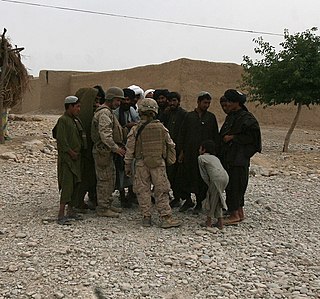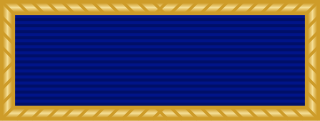
An ambush is a surprise attack carried out by people lying in wait in a concealed position. The concealed position itself or the concealed person(s) may also be called an "ambush". Ambushes as a basic fighting tactic of soldiers or of criminals have been used consistently throughout history, from ancient to modern warfare. The term "ambush" is also used in animal behavior studies, journalism, and marketing to describe methods of approach and strategy.

Guerrilla warfare is a form of unconventional warfare in which small groups of irregular military, such as rebels, partisans, paramilitary personnel or armed civilians including recruited children, use ambushes, sabotage, terrorism, raids, petty warfare or hit-and-run tactics in a rebellion, in a violent conflict, in a war or in a civil war to fight against regular military, police or rival insurgent forces.

A sniper is a military or paramilitary marksman who engages targets from positions of concealment or at distances exceeding the target's detection capabilities. Snipers generally have specialized training and are equipped with telescopic sights. Modern snipers use high-precision rifles and high-magnification optics. They often also serve as scouts/observers feeding tactical information back to their units or command headquarters.

The United States Air Force (USAF) is the air service branch of the United States Armed Forces, and is one of the eight uniformed services of the United States. Originally created on 1 August 1907, as a part of the United States Army Signal Corps, the USAF was established as a separate branch of the United States Armed Forces in 1947 with the enactment of the National Security Act of 1947. It is the second youngest branch of the United States Armed Forces and the fourth in order of precedence. The United States Air Force articulates its core missions as air supremacy, global integrated intelligence, surveillance and reconnaissance, rapid global mobility, global strike, and command and control.
The United States Armed Forces are the military forces of the United States. The armed forces consist of six service branches: the Army, Marine Corps, Navy, Air Force, Space Force, and Coast Guard. All six armed services are among the eight uniformed services of the United States, along with the U.S. Public Health Service Commissioned Corps and the NOAA Commissioned Officer Corps.

A military, also known collectively as armed forces, is a heavily armed, highly organized force primarily intended for warfare. Militaries are typically authorized and maintained by a sovereign state, with their members identifiable by a distinct military uniform. They may consist of one or more military branches such as an army, navy, air force, space force, marines, or coast guard. The main task of a military is usually defined as defence of their state and its interests against external armed threats.

Military intelligence is a military discipline that uses information collection and analysis approaches to provide guidance and direction to assist commanders in their decisions. This aim is achieved by providing an assessment of data from a range of sources, directed towards the commanders' mission requirements or responding to questions as part of operational or campaign planning. To provide an analysis, the commander's information requirements are first identified, which are then incorporated into intelligence collection, analysis, and dissemination.
In modern use, the order of battle of an armed force participating in a military operation or campaign shows the hierarchical organization, command structure, strength, disposition of personnel, and equipment of units and formations of the armed force. Various abbreviations are in use, including OOB, O/B, or OB, while ORBAT remains the most common in the United Kingdom. An order of battle is distinct from a table of organisation, which is the intended composition of a given unit or formation according to the military doctrine of its armed force. Historically, an order of battle was the order in which troops were positioned relative to the position of the army commander or the chronological order in which ships were deployed in naval situations.

Close-quarters battle (CQB), also called close-quarters combat (CQC), is a close combat situation between multiple combatants involving ranged or melee combat. It can occur between military units, law enforcement and criminal elements, and in other similar situations. CQB is typically defined as a short duration, high intensity conflict characterized by sudden violence at close range.
The Vietnam Service Medal is a military award of the United States Armed Forces established on 8 July 1965 by order of President Lyndon B. Johnson. The medal is awarded to recognize service during the Vietnam War by all members of the U.S. Armed Forces provided they meet the award requirements.

The Global War on Terrorism Service Medal (GWOT-SM) is a military award of the United States Armed Forces which was created through Executive Order 13289 on 12 March 2003, by President George W. Bush. The medal recognizes those military service members who have supported operations to counter terrorism in the War on Terror from 11 September 2001, to a date yet to be determined.
NATO Joint Military Symbology is the NATO standard for military map symbols. Originally published in 1986 as Allied Procedural Publication 6 (APP-6), NATO Military Symbols for Land Based Systems, the standard has evolved over the years and is currently in its fifth version (APP-6D). The symbols are designed to enhance NATO's joint interoperability by providing a standard set of common symbols. APP-6 constituted a single system of joint military symbology for land, air, space and sea-based formations and units, which can be displayed for either automated map display systems or for manual map marking. It covers all of the joint services and can be used by them.

Encirclement is a military term for the situation when a force or target is isolated and surrounded by enemy forces. The situation is highly dangerous for the encircled force. At the strategic level, it cannot receive supplies or reinforcements, and on the tactical level, the units in the force can be subject to an attack from several sides. Lastly, since the force cannot retreat, unless it is relieved or can break out, it must fight to the death or surrender.

Sissi is a Finnish term for light infantry which conducts reconnaissance, sabotage and guerrilla warfare operations behind enemy lines. The word sissi, first attested in the modern meaning "patrolman, partisan, spy" in 1787, comes to Finnish from Slavic and refers either to a forest bandit or his yew bow.

The Presidential Unit Citation (PUC), originally called the Distinguished Unit Citation, is awarded to units of the uniformed services of the United States, and those of allied countries, for extraordinary heroism in action against an armed enemy on or after 7 December 1941. The unit must display such gallantry, determination, and esprit de corps in accomplishing its mission under extremely difficult and hazardous conditions so as to set it apart from and above other units participating in the same campaign.

Military personnel or military service members are members of the state's armed forces. Their roles, pay, and obligations differ according to their military branch, rank, and their military task when deployed on operations and on exercise.

Command and control is a "set of organizational and technical attributes and processes ... [that] employs human, physical, and information resources to solve problems and accomplish missions" to achieve the goals of an organization or enterprise, according to a 2015 definition by military scientists Marius Vassiliou, David S. Alberts, and Jonathan R. Agre. The term often refers to a military system.

A rearguard or rear security is a part of a military force that protects it from attack from the rear, either during an advance or withdrawal. The term can also be used to describe forces protecting lines, such as communication lines, behind an army. Even more generally, a rearguard action may refer idiomatically to an attempt at preventing something though it is likely too late to be prevented; this idiomatic meaning may apply in either a military or non-military context.

Air force ground forces and special forces are the land warfare forces of an air force. They may include infantry, special forces, security forces, and military police. Airmen assigned to such units may be trained, armed and equipped for ground combat and special operations.

The Battle of Boz Qandahari occurred on 3 November 2016, in the village of Boz Qandahari, on the western outskirts of the Afghan city of Kunduz, between Afghan National Army Commandos alongside United States Army Special Forces against Taliban insurgents.

















